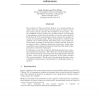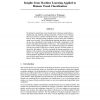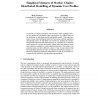NIPS
2003
13 years 6 months ago
2003
When clustering a dataset, the right number k of clusters to use is often not obvious, and choosing k automatically is a hard algorithmic problem. In this paper we present an impr...
NIPS
2003
13 years 6 months ago
2003
The problem of “Structure From Motion” is a central problem in vision: given the 2D locations of certain points we wish to recover the camera motion and the 3D coordinates of ...
NIPS
2003
13 years 6 months ago
2003
Dopamine exerts two classes of effect on the sustained neural activity in prefrontal cortex that underlies working memory. Direct release in the cortex increases the contrast of p...
NIPS
2003
13 years 6 months ago
2003
We explore the phenomena of subjective randomness as a case study in understanding how people discover structure embedded in noise. We present a rational account of randomness per...
NIPS
2003
13 years 6 months ago
2003
NIPS
2003
13 years 6 months ago
2003
NIPS
2003
13 years 6 months ago
2003
New feature selection algorithms for linear threshold functions are described which combine backward elimination with an adaptive regularization method. This makes them particular...
NIPS
2003
13 years 6 months ago
2003
We show that temporal logic and combinations of temporal logics and modal logics of knowledge can be effectively represented in artificial neural networks. We present a Translat...
NIPS
2003
13 years 6 months ago
2003
We propose a novel method of dimensionality reduction for supervised learning. Given a regression or classification problem in which we wish to predict a variable Y from an expla...
NIPS
2003
13 years 6 months ago
2003
Clustering aims at extracting hidden structure in dataset. While the problem of finding compact clusters has been widely studied in the literature, extracting arbitrarily formed ...



